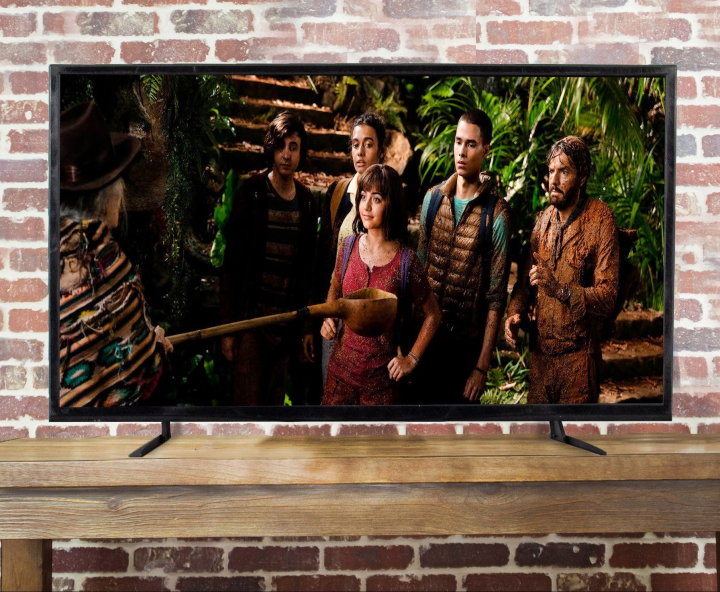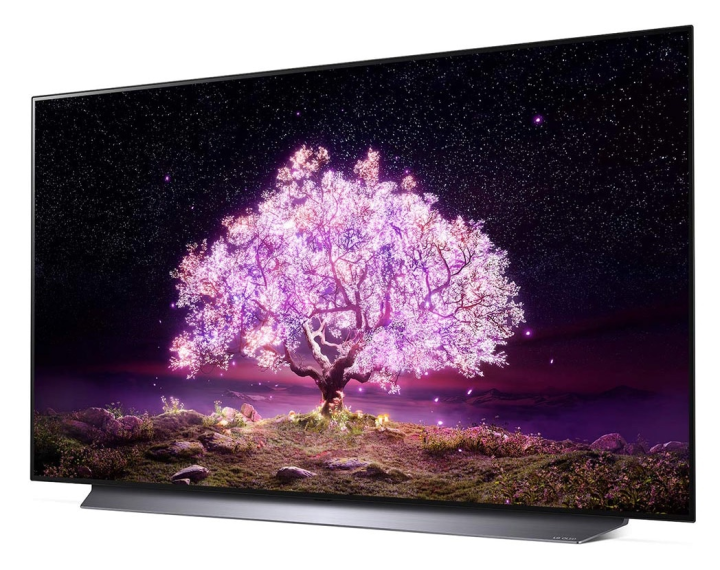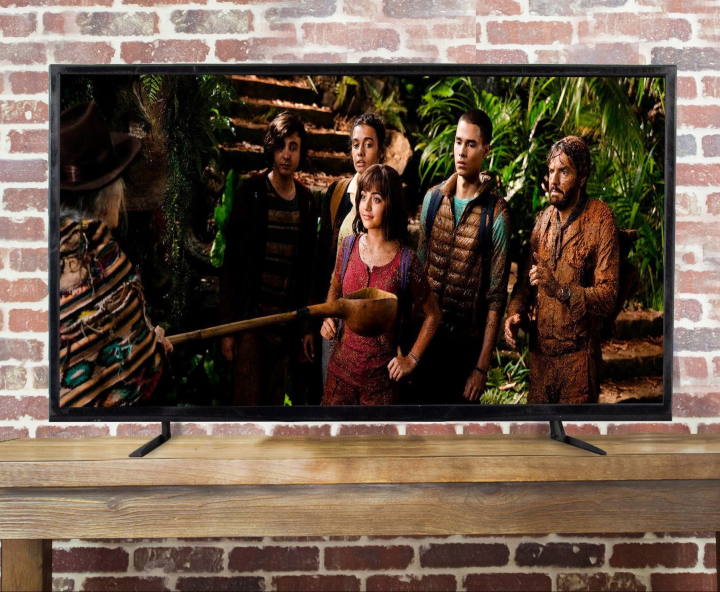
What happened was, our TV is ten years old and (following on some renovations) we could use one at the cabin for rainy winter evenings. So I bought a 48" LG C1 4K OLED screen (48" is the smallest in the C1 line), which is kind of this year’s hot TV. It’s not a life-changer, but the world of TV has shifted some in a decade, so here’s a dispatch from the front. Includes a pointer to a truly great TV stand.
By the way, this thing seems to be on sale at all the big boxes, which is a little weird given the global supply-chain crunch. We got ours at Costco, but in the US it seems Amazon has ’em cheaper. [Caution: Affiliate link.]
OLED · The Wirecutter and several other review sites I visited seemed pretty unanimous that LG and Sony OLED are ahead of the pack, and LG is quite a bit cheaper. Also I liked the look of the sets. OLED, compared to other display technologies, is said to offer more dynamic range, better color gamut, faster pixels, and other goodies.
What they keep coming back to is “blacker blacks”, so bear that in mind.
Blacker blacks!
4K · It means, basically, 3840×2160, which is to say 8,294,400 pixels. Does anyone really need that many? I got interested in the subject back in 2013 when 4K was new, and wrote code to figure out if there’s any value-add compared to regular HD (1920x1080, a mere 2,073,600 pixels).
In Is 4K BS? I concluded that the pixel count probably didn’t matter, but boy did that blog piece ever go viral, so I ended up writing More Things About TV, which noted (among other things) that the 4K spec also bumps the frame rate and color depth. And here too, blacker blacks come up.
So, does it make a difference? · Yeah, but… well, first of all, modern TVs have way smaller bezels, so even though our video cave is pretty small, we were able to replace a 42" model with a 48". And that does add impact. Also, these days they’re thinner and sleeker and generally easier on the eye — among other things, the backs are smooth black surfaces without vents and other uglification. So in fact I could have squeezed in the 55" but it’s OK, what we got is big enough.
As for the rest, well — and here’s the important part — it really depends on the source. Like a lot of people, our family watches streaming services, mostly episodic TV but some movies, and also live sports via a cable provider. Except for baseball, for which we subscribe to MLB.tv. The cable is still on 720p, no 4K there.
So, if you have a well-photographed, well-produced show, and if its visual palette is sort of noir, then yeah, a big 4K OLED is going to make you smile and say “Wow!” A couple of examples would be Lupin on Netflix and especially The Expanse on Prime. In particular the later seasons. Space, baby!
As for live sports, the story isn’t good. The picture comes nowhere near pushing the edge of what the screen can do. Note that MLB.tv is 4K as opposed to cable’s 720p, but still. You get a close-up on a batter’s face and OK, it’s dramatic, but then the crowd shots and wide whole-field views are super-disappointing. I know that they can do better. I wonder what the bottleneck is, and suspect it’s just stingy management that’s unwilling to pay up to pump more bits through the wires.
I’ve been thinking about dumping cable and subscribing to one or two sports streamers (in Canada, Sportsnet and TSN). It might save money; if it got me a better picture it’d be a no-brainer. But I suspect the problem isn’t with the streamers, it’s at the source, with the leagues. Anyhow, interesting territory.
Software · These days you have to worry about your TV’s operating system. The LGs come wth “WebOS”; when I saw that name I thought “Didn’t that used to be the nice Palm thing that was killed by iOS and Android?” It turns out that this is that; a distant successor, anyhow, that’s weaved back and forth between owners and in and out of Open-Source respectability. See WebOS on Wikipedia for details. Anyhow, it’s cool that the TV runs Linux.
And it’s pleasant enough to interact with. But mostly we don’t, because the little Roku box that drove the previous TV still works fine, and it spits out 4K and has Netflix and Prime and (unlike WebOS) MLB and plenty of other nice stuff. It turns out Roku is Linux too, so there.
I generally like Roku, it seems to pretty well Just Work and get out of the way. But I suppose they’ll turn out to be evil, just like every other big player in the entertainment ecosystem.
Privacy · Modern TVs spy on you. They are part of the global adTech ecosystem, a dismal, dark, diseased, and dysfunctional landscape that, generally speaking, contains nothing good.
“I’ll get a dumb TV,” you exclaim, “Then they can’t track me!” Well no, but your cable box still is, and if you have a Roku or a Chromecast or really any other widget that routes entertainment bytes from the Internet to your eyeballs, it’s probably tracking the hell out of you.
My neighbor has erected a small but exotic-looking “digital antenna” on his roof and tells me he gets lots of channels in rock-solid first-class high-resolution high def. And yep, nobody’s tracking him. But, no internet goodies for him either.
The situation isn’t hopeless. In my case, I care about the TV itself, the Roku, and the cable box. A bit of Web search reveals, for anything reasonably modern (in my case, the Roku & LG), how to minimize tracking. I’ve done that of course, but in my heart I think they’re probably lying liars who are watching my unhealthy affection for big soccer tournaments and anything with good space battles or that has Idris Elba.
And bear in mind that your mobile phone is tracking you all the time too, as are bushels and bushels of JavaScript embedded in pretty well every Web page you visit. So I’m going to suggest that the TV may not be the most intrusive internet-connected device decorating your lifestyle.
But I still hate being watched in the TV cave, and think someone should pass draconian legislation to end this travesty.
Imperfections · We are happy customers of Logitech Harmony remotes, which are now being discontinued because Logitech is evil and hates customers. I joyfully discovered that the C1 TVs are in the Harmony database; maybe one of the last things to be added? So I reconfigured our remote’s setup but now it won’t sync with any of our computers. There are a bunch of workarounds and hacks we haven’t tried yet, and if all else fails you can buy a new Harmony on eBay, still pretty cheap.
My heart sinks at the prospect of operating a system with a Roku and a cable box and disk player and a PlayStation and a Chromecast, all plugged into an A/V receiver, without some sort of universal remote. Wish us luck. And it seems totally batshit crazy that there isn’t a good business to be built around solving this problem.
One other thing. We watch Netflix & Prime via the Roku, but now the TV has them too. Maybe the picture is better that way? But I haven’t figured out how to make the Marantz AV receiver route the HDMI Audio Return Channel (ARC) from the TV to the speakers. I’ll probably wrestle it to the ground eventually.
Hardware elevation and VESA joy · There’s a problem with the LG TVs: They ship with this ugly low-riding plasticky-silver stand that positions the screen just barely above whatever surface it’s sitting on. Which raises the question: Where do the speakers go? Assuming that you don’t want to use the shitty ones built into the TV.
Whether you’ve got a (*sigh*) sound-bar or (as in our case) a pair of very decent little PSB Alpha speakers with an outboard subwoofer, these are things that want to sit under the TV. But with that base they can’t.
I’m here to help. I spent an absurd amount of time searching for “tv stands” and “monitor risers” and other permutations, thus routing money from Amazon to Google because all the unsatisfactory answers had Amazon at the top of the list, and that doesn’t come for free.
It took forever, but I hit pay dirt, in the form of the STAND-TV00Y (great product name there) from an outfit called VIVO. Based on this product, I will definitely have a close look at VIVO next time I need to configure a desk/monitor combo.
Our TV, like this one, is backed by a brick wall. I couldn’t resist this picture from the VIVO website, even though I’m deeply concerned about what’s in that ominous wooden ladle. I’m pretty sure the Worried Jungle People shouldn’t let the Stoned Jungle Person drink it.
Pardon me for going all fanboy, but this is brilliant. It comes with (and I sob that this should be such a rare thing) crystal-clear unambiguous directions for putting it together that Just Work.
I mentioned VESA (a.k.a. FDMI), which is the standard that describes how to fasten TVs to stands and booms and walls and so on. The VIVO uses that and my first experience with it is good. Except for, the stand comes with a little plastic multipouch containing a remarkable number of different-sized fastening bolts, because I guess VESA didn’t standardize that.
Should you upgrade? · Most people with TVs that work OK probably shouldn’t. But ten years’ progress does make a difference.
如有侵权请联系:admin#unsafe.sh

